 W
WThe Mexican angelshark is a species of angelshark. It occurs at depths of 70–180 m in the Gulf of Mexico and reaches a length of 88 cm (35 in).
 W
WThe striped bass, also called Atlantic striped bass, striper, linesider, rock or rockfish, is an anadromous perciform fish of the family Moronidae found primarily along the Atlantic coast of North America. It has also been widely introduced into inland recreational fisheries across the United States. Striped bass found in the Gulf of Mexico are a separate strain referred to as Gulf Coast striped bass.
 W
WThe striped burrfish or simply burrfish is a member of the porcupinefish family Diodontidae.
 W
WThe Gulf butterfish is a fish species of the family Stromateidae found in the Gulf of Mexico and off the coast of the Eastern United States.
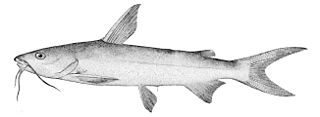 W
WThe hardhead catfish is a species of sea catfish from the northwest Atlantic and Gulf of Mexico, and similar to the gafftopsail catfish. It is one of four species in the genus Ariopsis. The common name, hardhead catfish, is derived from the presence of a hard, bony plate extending rearward toward the dorsal fin from a line between the catfish's eyes. It is an elongated marine catfish that reaches up to 28 in (70 cm) in length and 12 lb (5.5 kg) in weight. Their typical weight is less than 1 lb (450 g), but they commonly reach up to 3 lb (1.4 kg). They are often a dirty gray color on top, with white undersides.
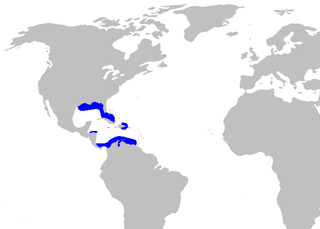 W
WThe broadgill catshark is a catshark of the family Scyliorhinidae, found in the Gulf of Mexico and the Caribbean Sea, between 30°N and 9° N, on the continental slopes at depths between 700 and 1,500 m. Its length is up to 46 cm. The reproduction of the broadgill catshark is oviparous.
 W
WThe Campeche catshark is a catshark of the family Schyliorhinidae. It is known only from the holotype, a 15.7 cm immature female found in the northwestern Bay of Campeche in the Gulf of Mexico. The specimen was collected at 1,057 m, a depth beyond current and probably future fishing pressure in the region. The reproduction of this catshark is oviparous.
 W
WThe chain catshark or chain dogfish is a small, reticulated catshark that is biofluorescent. The species is common in the Northwest Atlantic, Gulf of Mexico and Caribbean. It is harmless and rarely encountered by humans. It has very similar reproductive traits to the small-spotted catshark.
 W
WThe gulf chimaera is a species of cartilaginous fish in the family Chimaeridae found near Mexico, the United States, and possibly Suriname. Its natural habitat is open seas.
 W
WElacatinus oceanops, the neon goby, is a species of goby native to waters of the Atlantic and Gulf coast of North America from Florida to Belize. This cleaner fish can be found on coral heads at depths from 1 to 45 m. This species grows to a total length of 5 cm (2.0 in). This species can also be found in the aquarium trade.
 W
WEptatretus minor is a bathydemersal and non-migratory hagfish of the genus Eptatretus. It is found in the deep waters of the northern area of the Gulf of Mexico between Louisiana and Florida, at depths between 300 and 470 m. This hagfish is a relatively short and stout species, reaching a maximum length of nearly 40 cm. It is only known from a few specimens.
 W
WEtropus microstomus, the smallmouth flounder, is a species of fish belonging to the family Paralichthyidae.
 W
WEtropus rimosus, the gray flounder, is a species of flounder in the large-tooth flounder family Paralichthyidae. It is native to the western Atlantic Ocean, ranging from the coast of North Carolina to the south of Florida. It can also be found in the eastern Gulf of Mexico.
 W
WThe Gulf flounder is a species of saltwater flounder.
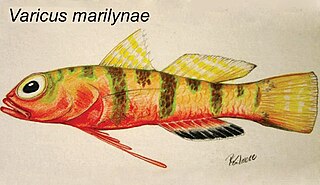 W
WThe orangebelly goby is a species of fish described by Gilmore in 1979. It is known only from a pair of specimens collected from the eastern and western sides of the Florida Peninsula.
 W
WThe violet goby is a species of goby native to marine, fresh and brackish waters near the Atlantic coast of North and South America from South Carolina in the United States of America, to northern Brazil. It prefers bays, estuaries and river mouths with muddy substrates. It is often marketed as the dragon goby or dragon fish.
 W
WThe marbled grouper, donkey fish, mutton hamlet, rockhind and sicklefish grouper, is a species of marine ray-finned fish, a grouper from the subfamily Epinephelinae which is part of the family Serranidae, which also includes the anthias and sea basses. It is a predatory reef fish which is found in the Western Atlantic Ocean.
 W
WThe blue striped grunt or bluestriped grunt, is a subtropical species of grunt native to the western Atlantic Ocean. It was described by the English naturalist George Shaw in 1803.
 W
WThe Gulf smooth-hound is a houndshark of the family Triakidae, found on the continental shelves of the tropical western central Atlantic. The reproduction of this houndshark is placental viviparous.
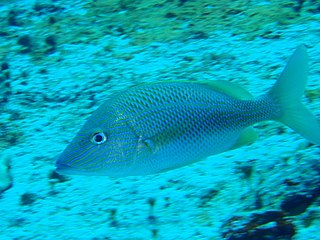 W
WHaemulon plumierii, the white grunt or common grunt, is a species of ray-finned fish in the family Haemulidae native to the western Atlantic Ocean. It grows to a length of about 30 cm (12 in) and is a silvery-cream color, with narrow yellow and blue longitudinal stripes, but can modify its color somewhat to match its surroundings. It is closely related to the blue striped grunt and the French grunt and often schools with these species. It feeds on shrimp, other crustaceans, annelids and mollusks, and is preyed on by larger piscivores such as barracuda and shark. It is sometimes caught by anglers as a game fish and its flaky white flesh can be eaten. It is also a popular aquarium fish.
 W
WThe Gulf hagfish is the only known species with the ability to enter brine pools, or pools of extremely high salt content, unharmed. These pools resemble lakes on the ocean floor. They exist in both the Gulf of Mexico and the Mediterranean Sea. The high salt content, approximately 200 ppt compared to 35 ppt for standard seawater, creates a buoyant surface which renders oceanic submersibles unable to descend into the pool. Often, other species can be seen floating lifelessly on the surface. It is believed that the pools only support bacterial life.
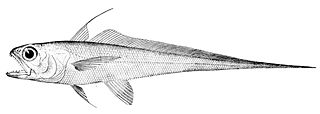 W
WThe luminous hake is a West Atlantic member of the Merluccidae family. It is the only member of its genus.
 W
WThe great hammerhead is the largest species of hammerhead shark, belonging to the family Sphyrnidae, attaining an average length of 4.6 m (15 ft) and reaching a maximum length of 6.1 m (20 ft). It is found in tropical and warm temperate waters worldwide, inhabiting coastal areas and the continental shelf. The great hammerhead can be distinguished from other hammerheads by the shape of its "hammer", which is wide with an almost straight front margin, and by its tall, sickle-shaped first dorsal fin. A solitary, strong-swimming apex predator, the great hammerhead feeds on a wide variety of prey ranging from crustaceans and cephalopods, to bony fish, to smaller sharks. Observations of this species in the wild suggest that the cephalofoil functions to immobilize stingrays, a favored prey. This species has a viviparous mode of reproduction, bearing litters of up to 55 pups every two years.
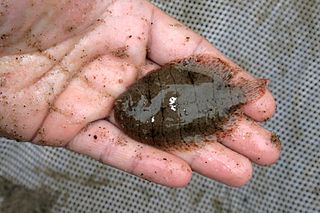 W
WThe hogchoker is a small flatfish found along the Atlantic coast of North America, ranging from Massachusetts and Florida to Panama. They prefer brackish water, and are abundant in many bays and estuaries north of the Carolinas. It is a member of the American sole family Achiridae. They are usually brown to dark brown in color, and lighter on their "blind side". The overall body color is often broken by a series of spots and thin stripes, which can be lighter or darker than the main body color. The fins and tail have fringed edges helping hide the fish from its prey. They mainly feed on small aquatic insects and invertebrates. They are regarded as "trash fish" by recreational fishermen and were fed to pigs but they have rather bony bodies which were sometimes difficult for the pigs to swallow, hence the vernacular name.
 W
WThe bayou killifish or bayou topminnow is a topminnow-like fish that thrives primarily in the shallow waters off the shores of the Americas, as well as fresh and brackish waters. Feeding off of small vertebrates and invertebrates, this fish displays reproduction techniques unique to its species.
 W
WThe Gulf killifish is one of the largest members of the genus Fundulus; it is capable of growing up to 18 cm in length, whereas the majority of other Fundulus reach a maximum length of 10 cm. Therefore, F. grandis is among the largest minnows preyed upon by many sport fish, such as flounder, speckled trout, and red drum. Fundulus derives from the Latin meaning "bottom," and grandis means "large". The Gulf killifish is native to the Gulf of Mexico from Texas to Florida and the eastern coast of Florida and the Caribbean Sea in the Atlantic Ocean. Threats to the survival of the Gulf killifish include extreme changes in salinity, changes in temperatures, and toxic events such as the hypoxic dead zone in Louisiana and the Deepwater Horizon oil spill. The Gulf killifish is currently being used to test the effects of oil and oil dispersants on the physiology of marine species affected by these substances. This is significant to conservation biology, because with the continued extraction of oil and other natural resources from North American waters, it has become increasingly important to understand the risks and consequences in worst-case scenarios, such as the Deepwater Horizon oil spill, and the lasting effects on the marine ecosystem.
 W
WThe rainwater killifish is a small silvery fish with yellow flashes and diamond shaped scales that is widespread from Cape Cod, Massachusetts, through to Tampico, Mexico. It is commonly found in large numbers in fresh to brackish estuarine environments. It feeds on tiny crustaceans, mosquito larvae, small worms, and mollusks. It can reach up to 62 mm.
 W
WThe striped killifish, also called the striped mummichog, is a North American species of fundulid killifish. It lives in salt and brackish waters in shallow coastal regions from New Hampshire to Florida, and in the northern Gulf of Mexico.
 W
WThe Atlantic Spanish mackerel is a migratory species of mackerels that swims to the Northern Gulf of Mexico in spring, returns to south Florida in the Eastern Gulf, and to Mexico in the Western Gulf in the fall.
 W
WThe Gulf menhaden is a small marine filter-feeding fish belonging to the family Clupeidae. The range of Gulf menhaden encompasses the entirety of the Gulf of Mexico nearshore waters, with the exception of the extreme eastern Yucatan and western Cuba. Evidence from morphology and DNA analyses suggest that the Gulf menhaden is the Gulf of Mexico complement to the Atlantic menhaden. Both species support large commercial reduction fisheries, with Gulf menhaden supporting the second largest fishery, by weight, in the United States.
 W
WThe sheepshead minnow or sheepshead pupfish is a species of ray-finned fish in the family Cyprinodontidae, the pupfishes. It is found in salt marsh and estuary environments and is native to the eastern coasts of North and Central America.
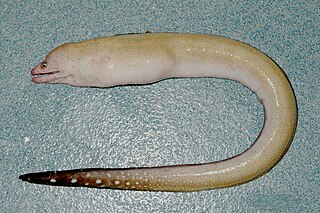 W
WThe blacktail moray eel is a moray eel found in the western Atlantic Ocean. It was first named by Böhlke and Böhlke in 1980.
 W
WThe northern pipefish is a northwest Atlantic species of fish belonging to the family Syngnathidae.
 W
WThe northern red snapper is a species of snapper native to the western Atlantic Ocean, the Caribbean Sea, and the Gulf of Mexico, where it inhabits environments associated with reefs. This species is commercially important and is also sought-after as a game fish.
 W
WOphidion josephi is a fish species in the family Ophidiidae. Widespread in the Western Atlantic from Georgia to Florida, also in the Gulf of Mexico. Marine tropical demersal fish. The specific name josephi refers to St Joseph Island in Texas where the type specimen was collected.
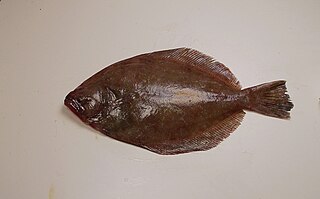 W
WParalichthys lethostigma, the southern flounder, is a species of large-tooth flounders native to the eastern and gulf coasts of the United States. It is a popular sports fish and is the largest and most commercially valuable flounder in the western North Atlantic Ocean and Gulf of Mexico. It is a "left-eyed flounder", meaning the left side is pigmented and is the "up side".
 W
WThe spottail pinfish is an ocean-going species of fish in the family Sparidae. It is also known as the Spottail seabream. Along with other members of their family, Spottail pinfish are occasionally eaten and considered by some to be a panfish.
 W
WThe Gulf pipefish is a member of the family Sygnathidae.
 W
WThe littlehead porgy is an ocean-going species of gamefish of the family, Sparidae. It is only found in the western portion of the tropical Atlantic Ocean where they are often caught and used as food.
 W
WThe Caribbean roughshark is a rough shark of the family Oxynotidae, found on the upper continental slopes of the Caribbean Sea, at depths between 400 and 450 m. It reaches a length around 50 cm (20 in).
 W
WThe belted sandfish, also known as the dwarf sea bass or stubby sea bass, is a species of marine ray-finned fish, a sea bass from the subfamily Serraninae, classified as part of the family Serranidae which includes the groupers and anthias. It is found in the western Atlantic Ocean. This species is found in the aquarium trade.
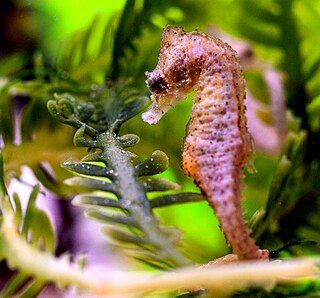 W
WThe dwarf seahorse is a species of seahorse found in the subtidal aquatic beds of the Bahamas and parts of the United States. It is threatened by habitat loss. According to Guinness World Records, it is the slowest-moving fish, with a top speed of about 5 feet (1.5 m) per hour.
 W
WThe skipjack shad is a North American, migratory, fresh- and brackish water fish species in the herring family Clupeidae. The name skipjack shad comes from the fact that it is commonly seen leaping out of the water while feeding. Other common names include blue herring, golden shad, river shad, Tennessee tarpon, and McKinley shad. The skipjack shad is restricted to the Gulf of Mexico drainage basins. Skipjack shad are found in clear to moderately turbid water in areas with flow. Because they are a migratory species, dams often impede their reproduction. Records suggest that this species was much more abundant in the Upper Mississippi River basin before it was impounded. Currently, the skipjack shad is most abundant in the Upper Mississippi River below the mouth of the Ohio River. They are known as an "early-run" species as they migrate to spawn in the early spring.
 W
WThe blacknose shark is a species of requiem shark, belonging to the family Carcharhinidae, common in the tropical and subtropical waters of the western Atlantic Ocean. This species generally inhabits coastal seagrass, sand, or rubble habitats, with adults preferring deeper water than juveniles. A small shark typically measuring 1.3 m (4.3 ft) long, the blacknose has a typical streamlined "requiem shark" shape with a long, rounded snout, large eyes, and a small first dorsal fin. Its common name comes from a characteristic black blotch on the tip of its snout, though this may be indistinct in older individuals.
 W
WThe clearnose skate is a species of cartilaginous fish in the family Rajidae. R. eglanteria is also known by other common names such as the brier skate and summer skate. Clearnose skates are easily identified by the translucent patches on either side of their snouts and their mottled dorsal surface. They are found along the Atlantic and Gulf coasts of the United States in shallow waters of the continental shelf.
 W
WThe roundel skate or Texas clearnose skate is a species of cartilaginous fish in the family Rajidae. It is found in the Gulf of Mexico, Southeast Florida and the Yucatan Peninsula.
 W
WThe blackfin snapper is a species of snapper native to the western Atlantic Ocean including the Gulf of Mexico and the Caribbean Sea. It is a commercially important species, though it has been reported to carry the ciguatera toxin.
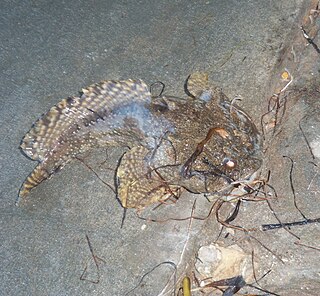 W
WThe Gulf toadfish is a species of toadfish found in the Gulf of Mexico.
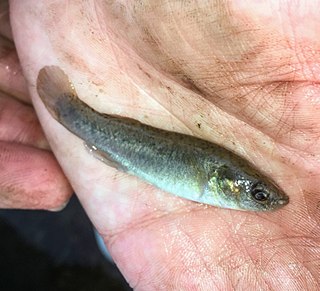 W
WThe saltmarsh topminnow is a species of killifish for the family Fundulidae. It occurs in the costal wetlands of the Gulf of Mexico in the United States.